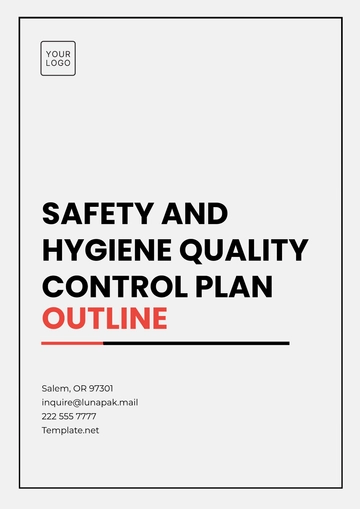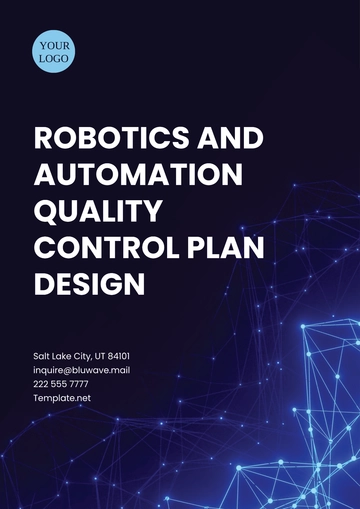Free Manufacturing Process Quality Control Plan

Prepared by:
[Your Name]
[Your Company Name]
1. Introduction
This Manufacturing Process Quality Control Plan delineates the procedures and requirements essential for maintaining consistent product quality and ensuring compliance with industry standards. It plays a pivotal role in minimizing defects and optimizing the overall manufacturing process. This plan is integral to our commitment to delivering high-quality products that meet or exceed customer expectations.
2. Scope
The scope of this plan covers all stages of the manufacturing process, from raw material procurement to final product delivery. It applies to all departments involved in production, quality assurance, and supply chain management. This comprehensive approach ensures that every aspect of production is monitored and controlled for quality.
3. Objectives
Ensure product quality meets or exceeds customer expectations.
Reduce waste and inefficiencies in the manufacturing process.
Comply with all relevant regulatory and industry standards.
Continuously improve processes through feedback and data analysis.
4. Quality Control Activities
4.1 Incoming Material Inspection
Implement rigorous inspection procedures for all incoming materials to verify quality and compliance with specifications.
Utilize sampling plans based on material criticality and supplier performance.
Document and maintain records of material inspections to track supplier quality over time.
4.2 In-Process Inspection and Testing
Conduct regular inspections and testing throughout the production process to detect and address defects as early as possible.
Establish checkpoints at critical stages of production for optimal quality assurance.
Utilize real-time monitoring systems to ensure immediate detection and correction of deviations.
4.3 Final Product Inspection
Perform comprehensive inspection and testing on a sample of finished products to ensure they meet quality standards before shipment.
Record and analyze inspection data to identify trends and areas for improvement.
Ensure finished products comply with all applicable regulations and customer specifications.
4.4 Non-Conformance Management
Develop a systematic approach for handling non-conforming products, including identification, segregation, and disposition.
Implement corrective and preventive actions to avoid recurrence.
Maintain detailed records of non-conformance incidents and actions taken.
5. Quality Control Tools and Techniques
Utilize various tools and techniques such as Statistical Process Control (SPC), Failure Mode and Effects Analysis (FMEA), and Root Cause Analysis (RCA) to enhance process monitoring and problem-solving capabilities.
Implement automated data collection and analysis systems to support continuous improvement efforts.
6. Documentation and Record Keeping
Maintain detailed records of all quality control activities, including inspection results, corrective actions, and continuous improvement initiatives.
Ensure documentation is accessible and updated regularly for audit and review purposes.
Implement a digital documentation system to enhance accessibility and streamline record-keeping processes.
7. Training and Competency
Provide comprehensive training programs for all employees involved in quality control to ensure they possess the necessary skills and knowledge.
Regularly assess and update training materials to reflect industry best practices and technological advancements.
Conduct regular competency assessments to ensure employees maintain high standards of quality control.
8. Performance Evaluation
8.1 Metrics and Key Performance Indicators (KPIs)
Establish measurable KPIs to assess the effectiveness of the quality control plan.
Regularly review performance data to identify trends and areas for improvement.
Implement a performance dashboard to provide real-time visibility into key quality metrics.
8.2 Continuous Improvement
Encourage a culture of continuous improvement by fostering open communication, feedback, and collaboration among all teams.
Implement changes based on performance evaluations and stakeholder input.
Utilize Lean and Six Sigma methodologies to drive continuous process improvements.
9. Conclusion
The successful implementation of this Manufacturing Process Quality Control Plan requires dedication and commitment from all levels of the organization. By adhering to the outlined procedures and continuously striving for improvement, we can achieve exceptional product quality and customer satisfaction. This plan not only ensures compliance with industry standards but also fosters
- 100% Customizable, free editor
- Access 1 Million+ Templates, photo’s & graphics
- Download or share as a template
- Click and replace photos, graphics, text, backgrounds
- Resize, crop, AI write & more
- Access advanced editor
The Manufacturing Process Quality Control Plan Template from Template.net is fully editable and customizable, perfect for ensuring efficient quality management. Easily tailor the plan to your specific manufacturing needs with our intuitive, editable AI Editor Tool. Streamline your quality control processes and maintain high standards with this flexible, professional template.
You may also like
- Finance Plan
- Construction Plan
- Sales Plan
- Development Plan
- Career Plan
- Budget Plan
- HR Plan
- Education Plan
- Transition Plan
- Work Plan
- Training Plan
- Communication Plan
- Operation Plan
- Health And Safety Plan
- Strategy Plan
- Professional Development Plan
- Advertising Plan
- Risk Management Plan
- Restaurant Plan
- School Plan
- Nursing Home Patient Care Plan
- Nursing Care Plan
- Plan Event
- Startup Plan
- Social Media Plan
- Staffing Plan
- Annual Plan
- Content Plan
- Payment Plan
- Implementation Plan
- Hotel Plan
- Workout Plan
- Accounting Plan
- Campaign Plan
- Essay Plan
- 30 60 90 Day Plan
- Research Plan
- Recruitment Plan
- 90 Day Plan
- Quarterly Plan
- Emergency Plan
- 5 Year Plan
- Gym Plan
- Personal Plan
- IT and Software Plan
- Treatment Plan
- Real Estate Plan
- Law Firm Plan
- Healthcare Plan
- Improvement Plan
- Media Plan
- 5 Year Business Plan
- Learning Plan
- Marketing Campaign Plan
- Travel Agency Plan
- Cleaning Services Plan
- Interior Design Plan
- Performance Plan
- PR Plan
- Birth Plan
- Life Plan
- SEO Plan
- Disaster Recovery Plan
- Continuity Plan
- Launch Plan
- Legal Plan
- Behavior Plan
- Performance Improvement Plan
- Salon Plan
- Security Plan
- Security Management Plan
- Employee Development Plan
- Quality Plan
- Service Improvement Plan
- Growth Plan
- Incident Response Plan
- Basketball Plan
- Emergency Action Plan
- Product Launch Plan
- Spa Plan
- Employee Training Plan
- Data Analysis Plan
- Employee Action Plan
- Territory Plan
- Audit Plan
- Classroom Plan
- Activity Plan
- Parenting Plan
- Care Plan
- Project Execution Plan
- Exercise Plan
- Internship Plan
- Software Development Plan
- Continuous Improvement Plan
- Leave Plan
- 90 Day Sales Plan
- Advertising Agency Plan
- Employee Transition Plan
- Smart Action Plan
- Workplace Safety Plan
- Behavior Change Plan
- Contingency Plan
- Continuity of Operations Plan
- Health Plan
- Quality Control Plan
- Self Plan
- Sports Development Plan
- Change Management Plan
- Ecommerce Plan
- Personal Financial Plan
- Process Improvement Plan
- 30-60-90 Day Sales Plan
- Crisis Management Plan
- Engagement Plan
- Execution Plan
- Pandemic Plan
- Quality Assurance Plan
- Service Continuity Plan
- Agile Project Plan
- Fundraising Plan
- Job Transition Plan
- Asset Maintenance Plan
- Maintenance Plan
- Software Test Plan
- Staff Training and Development Plan
- 3 Year Plan
- Brand Activation Plan
- Release Plan
- Resource Plan
- Risk Mitigation Plan
- Teacher Plan
- 30 60 90 Day Plan for New Manager
- Food Safety Plan
- Food Truck Plan
- Hiring Plan
- Quality Management Plan
- Wellness Plan
- Behavior Intervention Plan
- Bonus Plan
- Investment Plan
- Maternity Leave Plan
- Pandemic Response Plan
- Succession Planning
- Coaching Plan
- Configuration Management Plan
- Remote Work Plan
- Self Care Plan
- Teaching Plan
- 100-Day Plan
- HACCP Plan
- Student Plan
- Sustainability Plan
- 30 60 90 Day Plan for Interview
- Access Plan
- Site Specific Safety Plan
























